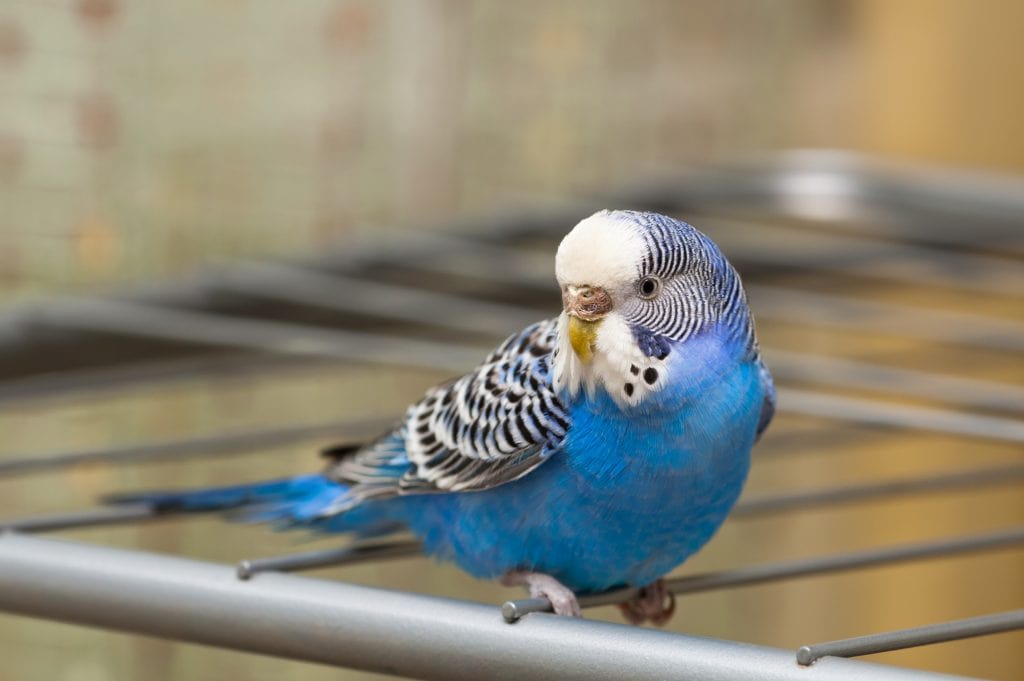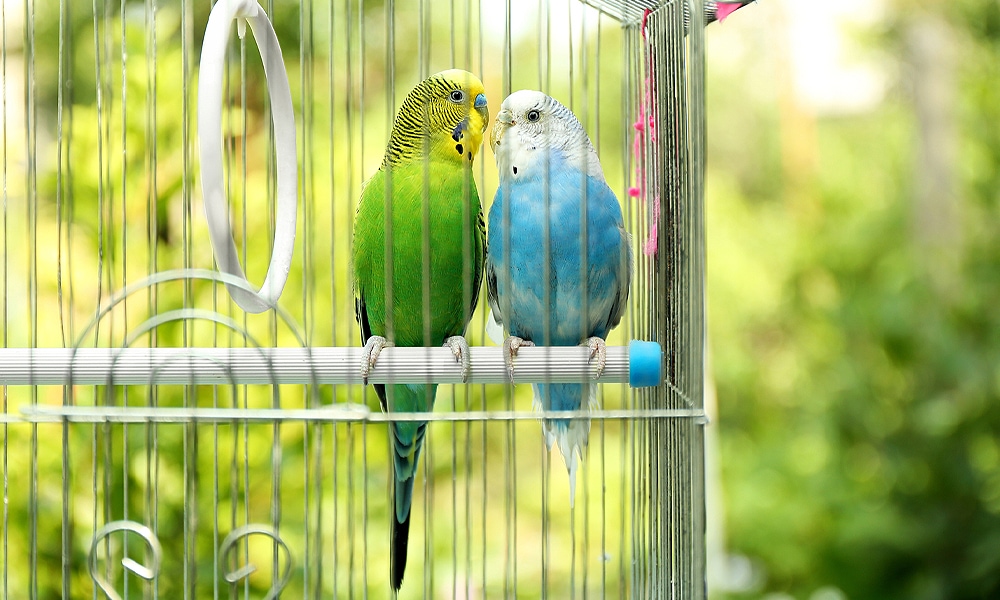‘How long do parakeets live’ is a common question foremost on the minds of people who wish to keep parakeets (or keets as they are fondly known) as pets? After all, knowing the lifespan of your pet bird is essential to determine whether it is indeed suitable as a pet for your lifestyle.
This knowledge can also go a long way in helping you give your bird the best care so that it can live a long and healthy life. So let us find out how long do budgies live in order for you to make the right choice in their care.
- How long do parakeets live in captivity?
- Wild parakeet lifespan vs. parakeets in captivity
- How to tell the age of your Parakeet?
- Main factors affecting parakeet life expectancy
- Oldest living parakeet
- How to tell if your parakeets are healthy?
- What to do if your parakeet gets sick?
- How long do pet birds live?
- How long can birds live?
How long do parakeets live in captivity?
On average, a parakeet lives for about 6 to 12 years in captivity (1). This number, of course, depends on the type of care you give your bird. The lifespan also depends on the overall health, lineage of the bird, the kind of diet and exercise it receives, etc. In the wild, the average budgie lifespan is around 15-20 years.
Here are some parakeet species and the average lifespan in captivity.
- Budgerigar – The budgerigar lifespan is an average of 5-8 years in captivity (1). This number is greatly influenced by the kind of care it received: diet and exercise, as well as its lineage and overall health.
- Monk parakeet – Monk parakeets, also known as Quaker parakeets, live a long life of about 15-20 years. In the wild, they can live up to 25-30 years. How long does a bird live naturally depends on its overall health, the breed, its lineage, food, exercise, as well as its mental disposition.
- Plain parakeet – The plain parakeet lifespan in captivity is about 15 years. Where are parakeets from – this type of parakeet is native to Brazil. With excellent care, you can extend your plain parakeets’ age to 18-20 years.
- Grass parakeet – A grass parakeet can easily live for 10 years. Where do parakeets come from- This parakeet is native to Australia. The lifespan, as with other parakeets, depends on the health care it receives, its diet, its parents’ health or genetics, etc.
- Barred parakeet – Also known as a lineolate parakeet, the Barred Parakeet has a lifespan of 10 years. The lifespan of parakeets of this type depends on the nourishment it receives, its genetics or lineage, hereditary illnesses if any, and overall lifestyle, health care, diet, and exercise afforded by its owners.
- Mustache parakeet – The life expectancy of the parakeet of the Mustache variety is 20-25 years. This number is determined by the diet, overall health, mental and physical fitness, as well as the exercise your captive bird receives.
- Rose-ringed parakeet – The Rose-Ringed parakeet lifespan is nearly 25-30 years. There is a record of one Rose-Ringed parakeet living up to 50 years! The South American native needs plenty of good food, exercise, and mental stimulation to ensure a long and healthy life.
- Green-cheeked parakeet – The Green cheeked budgie lifespan is nearly 30 years, but neglect by the owner can reduce it to only 10 years.
- Golden parakeet – The Golden parakeet can easily live up to a ripe old parakeet age of 30 years in the wild and up to 20-25 years in captivity with proper care.
Also read: Parakeet Care: Everything You Need to Know
Wild parakeet lifespan vs. parakeets in captivity
The average lifespan of common parakeet species in the wild is 25-30 years. This number drastically reduces to about 10 years in captivity.
However, how long do pet birds live entirely depends on the owners: the kind of care they are willing to give their pets. With proper nutrition and exercise, a pet parakeet can easily live to 10-12 years or longer.
Wild happy parakeets singing and flying about all day in search of food and water have a lesser risk of obesity. This is one of the reasons why they live longer, healthier lives compared to their captive counterparts. They also flock in numbers of 20,000 to 30,000 and this too might keep them safe from predators.
How long can parakeets live in captivity depends mainly on the kind of nourishment they receive, their safety from environmental hazards, as well as physical and mental health care.

It is very important that owners ask themselves: how do I know if my bird is happy since depression is a leading indirect cause of premature death in captive parakeets. Thus, apart from diet and exercise, you can increase the life expectancy of a parakeet by keeping it mentally stimulated as well.
Inbreeding is another cause of reduced lifespan in captive or pet parakeets. Breeding closely-related birds result in congenital defects, which can shorten the parakeets’ lifespan. How can you tell how old a parakeet is dependent on some factors which we will discuss shortly.
Also read: 12 Best Toys for Parakeets to Keep em’ Happy
Here are some common parakeet species and factors for their death in captivity
- Budgies – What age do budgies live until? The answer is about 5-8 years, which can be extended to 10-12 years with good care. Common causes of death in pet budgies include exposure to certain toxic foods like chocolates, smoke, and mental illness stemming from inadequate nourishment or lack of exercise, as well as certain viruses. We will discuss how to tell the age of a budgie later on in this guide.
- Blue parakeet – Blue parakeet lifespan in captivity, with good care, is about 15-20 years. A common cause of death in the blue parakeet is PBFD or Psittacine Beak and Feather Disease.
- Grass parakeet – How long do parakeets live as pets depend mainly on their diet. Dehydration, eating too much food, trauma, certain viral diseases, and lack of exercise and mental stimulation are some of the common causes of deaths in grass parakeets.
How to tell the age of your Parakeet?
Indoor parakeets go through different life stages. How can you tell how old a parakeet is can be based on the characteristics they normally depict at that age. Here are some age-wise characteristics of indoor or captive birds:
- Juvenile – This is the age between 6 weeks to 6 months. A healthy juvenile bird will be curious, happy, and explorative, open to new food and toys, and ready to interact with other birds. You will find your baby parakeets engaging in comical activities by themselves or with other birds.
- Young adult – This is the age between 6 months to 2 ½ years. Your budgie will be more confident, have limitless energy, and still open to new toys and food. It may be slightly cautious around new people.
- Middle age – At this age, the energy levels decrease considerably. However, your bird will still fly, walk, climb, and do the things it normally does, albeit slower. It may have established food and toy preferences. It may have a preferred group of birds it interacts with. Usually, budgies in this age group form bonded pairs.
- Senior age – You will find your budgie taking longer naps throughout the day. It may not chatter as much as it did earlier. Your bird will also eat smaller meals. Its flying strength would have waned a bit. Its feathers may not grow back as before after molting and, as a result, it may be more susceptible to temperature changes.
- Impending death – Owners can usually tell how long do pet birds live since a budgie will usually know 24 hours prior to its death. It might play with a favorite toy it hasn’t touched for a while, have one large favorite meal, sing a favorite song, and even get more energetic during the last day before impending death. They might even groom their partner, feed them, sit next to them, or try to keep their mate warm.
Also read: How to Sex a Parakeet? (Step-by-Step Guide)
Main factors affecting parakeet life expectancy
The following factors affect greatly on how long does parakeet live.
Environmental factors – Budgies have complex respiratory systems and they are easily affected by toxic fumes, pollution, household cleaners, Teflon coated cookware, cigarette smoke, toxic plants, etc.
Budgies also startle easily and sudden noises can cause them to fly into cage bars leading to traumatic injuries. Therefore, how long do parakeets live in captivity depends entirely on how you protect your pet from these environmental factors.
Healthy diet – A healthy diet is very important to keep your budgie disease-free. Since parakeets have fewer fat reserves, any missed meals or inadequate water intake could quickly translate into ailments or serious dehydration.
Proper cage – A small, unclean cage can make your budgie feel trapped and also make it prone to illnesses-physical and psychological. Banging against the cage walls could result in broken bones, which can result in bleeding and increased susceptibility to infections. That’s why it’s essential to pick the right cage for your bird.
Veterinary care – If you are wondering do parakeets need to go to the vet. The answer is yes. Broken bones can result in budgies since the bones are rather fragile and hollow. Failure to fix this can leave your pet susceptible to internal bleeding and infections.
Also read: 10 Parakeet Treats to Make Your Birds Happy
Oldest living parakeet
According to the Guinness Book of World Records (2) the oldest living parakeet was a budgie hen bird named Charlie. She lived to a ripe old age of 29 years and 2 months and was also known as Charlie the Curser. Charlie was owned by Miss J Dinsey of Stonebridge London.
How to tell if your parakeets are healthy?
A parakeet can be considered healthy if:
- It has clean toes and feet
- It is cheerful, active, and curious
- There is no crusting around its eyes or beak
- It shows curiosity to make friends with other birds and humans
- It shows an interest in its cage, toys, and perches.
Also read: Can Parakeets Talk? (+How to Teach ’em)
What to do if your parakeet gets sick?
Common signs and symptoms of a sick parakeet:
Wet, runny droppings – If your bird is lethargic and has wet, runny droppings, or the feathers in the rear end appear dirty, then it could be a condition called coccidiosis. You can wait a few days, make dietary changes like feeding just seeds, and see if that makes any changes in the conditions. If symptoms persist, see a vet immediately.
Parrot fever/ornithosis – This condition (3) is characterized by tears continuously flowing from your birds’ eyes. If you suspect that your bird has chills and fever, see a vet right away.
Rectal prolapse – This condition causes the intestines to move out of place. It may be characterized by a red marble sticking out of the bird’s rear. If you notice this, please see a vet right away. Surgical intervention may be needed in such cases.
Please do not try to treat a sick parakeet at home. If something seems off with your bird, take her to the vet right away.
How long do pet birds live?
How long can birds live depends on various factors like genetics, diet, environmental factors, exercise, etc. Here are some life span averages of common pet birds:
- English Budgie – 7 to 8 years
- American budgie (parakeets) – up to 14 years
- Love birds – 40 to 50 years
- Cockatiels – 10-20 years
- Cockatoos – 50-70 years
- Parrots – 60-70 years
- Finches – 5 to 10 years
As far as pets are concerned, birds live longer compared to most dog and cat breeds. Naturally, the lifespan of birds in captivity is always related to the kind of care they receive and whether or not their needs are met.
Always maintain good hygiene and feed your pet birds the best nutrition as advised by your vet. Make sure you take your bird for regular vet checkups because qualified avian vets can quickly pick up subtle signs whether a bird has some underlying health issue.
Also read: 12 Most Colorful Parrot Species in the World
How long can birds live?
How long does a bird live in the wild depends on its habitat, genetics, and size. Smaller the bird, shorter its life span and larger the bird, longer is its average life span.
Barring accidental deaths, birds in the wild can be expected to live longer than those in captivity. Disease, starvation, predators, extreme weather conditions, and brood parasitism (4) are some of the common causes of death in wild birds.
Parakeets in the wild often live to a ripe old age of 15-20 years, provided they are not eaten by bigger birds or meet with some untoward environmental hazard.
In the cage, parakeets or budgies can also live up to 10 years as long as you allow them some daily time outside the cage, ensure a healthy diet, provide them with regular mental and physical exercise and also take them for regular vet checkups.
Also read: 12 Best Parakeet Cages (Flight, Travel & Playtop Options)



My keets are Blue & Powder